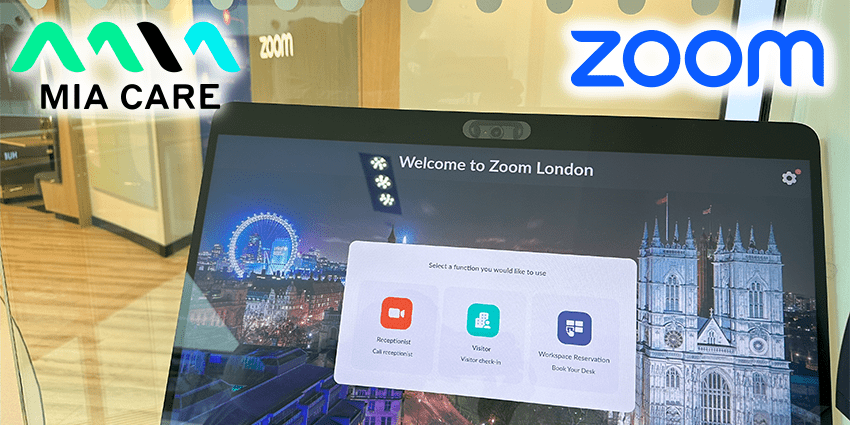After recalling employees back to the office, Zoom talks to UC Advanced about how they have designed their new office spaces.
How do you organise your workspace? It’s a huge question facing businesses right now.
That’s an almost comical dilemma to pose to businesses when you think about the working conditions that greeted us before the turn of the decade. But just like Tottenham Hotspurs in European competitions, those days are gone!
Fact is, rather than employees fighting to work from home, employers are now finding clever ways, usually in employment contracts, to make them come into the office, resulting in what we all know now as the great resignation.
So what’s the answer? Frankly, who knows? Are those businesses who want to restore a sense of community “calling everyone back to the office”? I don’t think that’s necessarily true. Is every business that doesn’t use an office missing out? Again, not necessarily the case.
We are all getting used to this hybrid working schtick. Those that say they have cracked it would appear to be ahead, but if a company like Zoom has called for a partial return to the office, maybe, just maybe, there’s something to be learnt.
Why now?
After three years of enabling us all to work from home, it can hit a little hypocritical that now Zoom is advocating for office spaces to be full of employees.
So what has changed? Why has Zoom made this U-turn? According to Alana Collins, Head of Real Estate & Workplace, this decision is all about practising what Zoom preaches.
“We’ve heard from surveys and studies from our partners in our business, our customers, and the same thing keeps coming back: People want to come to the office, to socialise, and to collaborate and to innovate. Our customers are asking us for solutions to make the journey to the office better because people’s lives have shifted and businesses are bringing their folks back to the office.
“This new office is about drinking our own champagne, we are walking the walk. With this office we wanted to make sure that each space had a different offering and a different experience so that when people came to the office, they could kind of curate and pick how they wanted to work, because each team works very differently.
“We are also showcasing the variety of different solutions Zoom has to offer. Our old office was a fixed space that was designed five years ago. We knew that it had to be technology-focused with our latest and greatest solutions, and use things like Intelligent Director, so our employees learn how to use it. This office is a great way to educate our team members so they can sell it to our customers and provide solutions for them in turn.”
New Digs
In order to be seen to be walking the walk, Zoom opened a 15,000 square-foot office space in Holburn, London this summer, making the case for the ideal workspace that is split between different areas of hot desks, glass meeting rooms, and private boardrooms, amongst other areas.
Of course, the same Zoom interface is running throughout, to the point where gaining access to reception without a pass is a Zoom call away. This UX also has oversight of where people are planning to work at every point in the day, can also suggest the best places to sit that day, and is designed to be the first interaction point before coming into the office.
“Employees want their path to the office to be easy,” said Collins. “That’s why we’re allowing our employees to start their journey on an app. Before they even leave the house, they can get their parking set, order lunch, book a certain conference room for the right size of the meeting, book an open collaboration space if you know your team is going to come together, and raise tickets to add something like a rolling whiteboard in the space.
“The dashboard is key to evolving this new strategy. Now businesses can understand what in the space is being used, what is not being used, and what the most favoured technology is, and lean into that. The analytics has changed my career immensely, I’m able to learn every single day how people are using our office spaces.
“We now know engineers work very differently than salespeople or marketing folks, this [office in London] is predominantly a sales office, but if it was an engineering centre I think we would curate the space a little bit differently, have more booths, make it quieter with some acoustic panelling in the ceiling, and some different lighting because they’re staring at their screen, coding and generally work very differently than the [sales] team that is here.”
Leading by example
As for Zoom, Collins said that they will continue to innovate, as well as help businesses make the best use of the property they inhabit.
“I think our position in the market is more about educating,” said Collins. “We’re not saying businesses should kit out their offices in a certain way. Instead, we’re giving them a kind of path to design their workplace for an evolving culture.
“I think it’s okay to say that we’re experimenting, we’ve done a few successful pilots and some that have not been a success, but we’ve learned a lot from each of them. That’s how we continue to be innovators and thought leaders.
“Real estate and the workplace has a bigger part in culture now than it ever did. We’re not going back to a sea of desks with assigned seating anymore, we want people to have the flexibility and the freedom to move about the space and use it in different ways. It’s not just coming to the office to sit at your desk and be on Zoom all day.”
